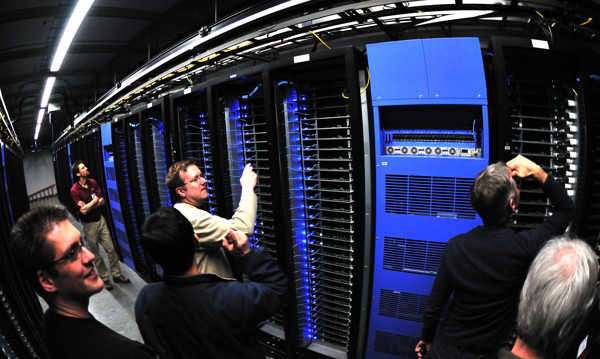SAN FRANCISCO—VMware is still the big kahuna in virtualization, and the company is hosting its annual VMworld conference this week to show off the latest shiny bits of software that businesses can buy for their data centers. We’ll be covering the event in San Francisco to keep you up to date.
Details on the VMware public cloud service that will compete against Amazon could be in the offing. While servers and cloud computing will dominate the agenda today, updates on end user computing (possibly including dual-persona phones) will come tomorrow. For now, we can talk about the new products VMware was willing to reveal in advance of the show.
NSX
Along with a new version of its core vSphere virtualization platform, VMware is unveiling new software to virtualize networks and storage. All of these tools, when combined with the forthcoming public cloud service, will help VMware stay competitive against the likes of Microsoft, Red Hat, and the open source OpenStack cloud infrastructure-as-a-service platform.
Today, the company is announcing VMware NSX, network virtualization software designed to “deliver the entire networking and security model from Layer2 to Layer 7 in software, decoupled from underlying networking hardware,” in VMware’s words. It’s not exactly a new product—it combines VMware’s existing vCloud and Network Security (vCNS) tools with the technology of Nicira, which VMware bought a year ago.
The core parts of NSX include logical switches and routers along with a RESTful API for integration into third-party cloud management platforms, plus a logical firewall, load balancer, and VPN.
“The platform is built around a controller cluster that manages the distribution of logical network functions into hypervisors throughout the data center,” VMware said. “The NSX platform delivers the base Layer 2 and Layer 3 network virtualization with add-on software modules for specific Layer 4-7 network services, such as firewall, load balancer and VPN.”
While NSX integrates with vSphere and the vCloud Director and Automation Center management tools, it also works with hypervisors and management software beyond VMware’s. That includes the Xen Server and KVM hypervisors and the OpenStack and CloudStack cloud management platforms.
NSX will be available in Q4 2013 for a price that has not yet been announced. But the basic networking components that VMware already offers are available in the main vSphere platform, which VMware customers typically own.
“The vCloud Networking and Security that are already in the core vSphere platform will remain there at least for now,” Gartner virtualization analyst Chris Wolf told Ars via e-mail. “I expect customers that just want basic network virtualization features to stick with vCNS.” vCNS includes a virtual firewall, VPN, and load balancing.
Big, virtual data
Beyond networking, VMware is virtualizing storage—and not for the first time. vSphere already has a virtual storage platform, but VMware said it’s going to provide something better in the form of Virtual SAN (vSAN). This lets IT shops “instantly provision VM storage using simple policies” and scale storage capacity and performance up automatically as a cluster of virtual servers grows.
“vSAN is a big deal,” Wolf said. “With vSAN, customers can pool local storage on servers and create a storage network without needing any traditional SAN hardware—just servers and local disks. This is a big component for enabling the software-defined data center, and over the long term, vSAN can help organizations reduce their reliance on hardware-based storage solutions. We expect clients to start using vSAN in dev/test environments as a way to cut costs and potentially expand vSAN deployments to VDI [virtual desktop infrastructure] workloads as well.”
One big difference between vSAN and VMware’s previous storage software is that “you can use local storage and still be able to take advantage of live migration [the ability to move virtual servers from one physical machine to another with no downtime] and high availability,” Wolf said. “Previously, organizations would need a third party product like the HP Lefthand VSA to do it. Also, vSAN storage is replicated and highly available. So if a server fails you won’t lose any data.”
vSAN is heading into a public beta, and general availability is planned for the first half of 2014.
As for the core virtualization platform, VMware is unveiling vSphere with Operations Management version 5.5. A vSphere instance can now manage 320 physical CPUs, up from 160 in vSphere 5.1. Memory support was doubled to 4TB, and support for virtual CPUs doubles to 4,096. The maximum size of a VMDK (virtual machine disk) has dramatically risen from 2TB to 62TB.
Beyond the numbers, some new features make it easier to deploy certain applications and recover from failure. vSphere is now better able to handle the needs of applications requiring low latency, such as in-memory databases, VMware said. Also, a new “Flash Read Cache” virtualizes server-side flash storage to provide a “high performance read cache later that dramatically lowers application latency.”
A new high availability feature places an agent inside a virtual machine to monitor the traffic and activity of the application running inside. When something abnormal happens, the VM can be automatically rebooted or a notification can be sent to an administrator. Previously, VMware high availability software would not necessarily realize an application was misbehaving if the virtual machine itself looked fine, VMware product marketing executive Peter Wei told Ars.
Full Story: VMware re-virtualizes networks and storage to keep pace with the cloud | Ars Technica.

